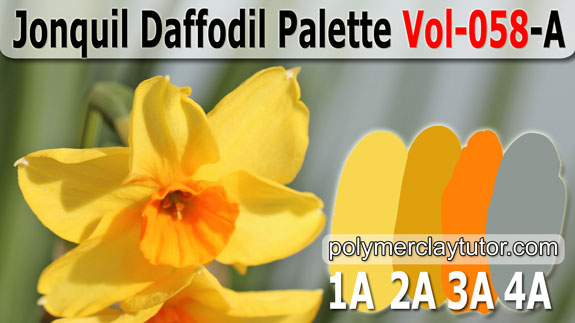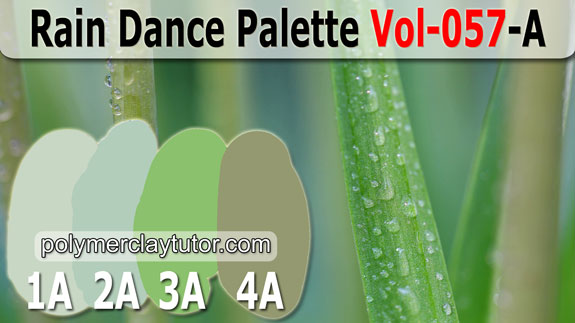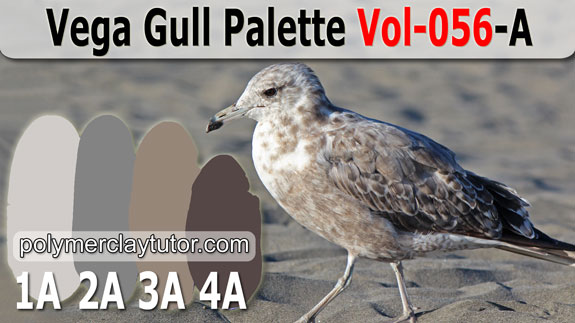Member Benefits 060: Techniques Tools
Filed in 3: Member Benefits,Techniques Tools, May 2, 2013, 11:01 am WOW thank you for this Cindy. I have always loved the mica shift technique, but was never good at it. You taught me something new that will help a lot, and that was the putting the clay on the rounded surface to slice. I am anxious to try the slicing that way. I am not good at the bending of the blade. Thanks again for a great, informative video. ~Kriss-J >> Original comment was posted here: Polymer Clay Mica Shift Tutorial
WOW thank you for this Cindy. I have always loved the mica shift technique, but was never good at it. You taught me something new that will help a lot, and that was the putting the clay on the rounded surface to slice. I am anxious to try the slicing that way. I am not good at the bending of the blade. Thanks again for a great, informative video. ~Kriss-J >> Original comment was posted here: Polymer Clay Mica Shift Tutorial
I made some extruder canes today coverd some old beads and I love it, it was so easy I just wanted to go on and on making more. If Makins made a very large exruder, wow could we have fun lol. Thank you Cindy. ~Ritzs >> Original comment was posted here: Polymer Clay Instructions
Just wanted to let you know that this video has kicked my butt into gear with getting into clay jewelry design. I’ve been sitting on the idea for a while. I was teetering the line of “no it doesn’t look authentic so I won’t try it” mentality until I saw your opals. Opals are my favourite of the delicate precious stones and I couldn’t believe how realistic your clay opals look! Thanks! ~Katrina-S >> Original comment was posted here: Polymer Clay Faux Opals
Vol-059: Polymer Clay Barrettes (6 Videos)
Filed in 1: Video Tutorials,Bead Projects, April 4, 2013, 11:03 amRivets, Eyelets, No Glue. Scroll Down For Links To All 6 Videos. |
Vol-059-1: Video #364: Intro (that clip just above): In this 6 part video tutorial series, you will learn techniques and tricks that will have you creating beautiful, unique and professional looking French style hair Barrettes in any style, size and surface technique you wish. Lessons learned in this tutorial include, silk screening, molding, texturing, layering, using canes, riveting and setting eyelets in polymer clay.
Vol-059-2: Video #365: Silk Screening On Polymer Clay: In this video I will show you the technique of silk screening on polymer clay. It can be done on both raw and baked polymer, and can be used for making the Butterfly Barrette demonstrated in the video. This is a very useful technique to add to your general polymer clay bag of tricks.
Vol-059-3: Video #366: Molded Cherry Blossom Barrette: In this video I will show you how to use texture plates and silicone molds to create a beautiful sculpted barrette. You can use the techniques learned in this tutorial with all kinds of texture plates and molds that you have access to. The possibilities are truly endless.
Vol-059-4: Video #367: Canes & Other Surface Techniques: Polymer clay barrettes are very well suited for using your own cane designs with, as well as any other polymer clay technique that suits your fancy. Previous tutorials such as Faux Labradorite, Faux Rust, Faux Wood, Aurora Technique, Easy Kaleidoscope Canes, Pirate Canes, Leopard Canes, Zebra Canes are all excellent candidates for making into great hair clips. This video deals with the design challenges you may face when using your own polymer clay ideas and how to plan ahead for the best end result.
Vol-059-5: Video #368: Nail Head Rivets: One awesome way to fasten your polymer clay art to a barrette blank is riveting. I will show you when, where and how to use this great little connector so that your piece not only looks great, but functions great too!
Vol-059-6: Video #369: Using & Setting Eyelets: In this final video I will show you the ins and outs of setting eyelets in polymer clay, while helping you to put together a finished barrette using the silk screen butterfly we made in Video #365. Here you will learn design and technique tips that will help you to create strong connections with your eyelets that look great on the front as well as the back. As an added bonus I will show you a neat and easy way to add a little bling and sparkle to your eyelets using Swarovski Flat Back Crystals.
By the way, many of the “shopping” links I provide for the various tools and supplies used in my tutorials, are “affiliate” resources. That means companies like Amazon and the other suppliers I refer, pay me a small commission if you click on the links and end up making a purchase at their site. It’s not a lot, but every little bit helps in keeping the cost of my tutorials down. And, the prices for products that you may purchase through my links, are exactly the same as what you would normally pay, even if it is a “sale” price. So please feel free to click whenever you need to pick up a few things for your studio. Thanks so much for your support.
Vol-059: Sunday Market A-Palette (4 Premo Color Recipes)
Filed in 2: Color Recipes,Orange,Purple,Red, , 11:02 am |
1-A: Watermelon Dahlia 2-A: Salmon Tulips 3-A: Purple Limonium 4-A: Purple Millet  |
Watermelon Dahlia is the beautiful watermelon red of the fat Dahlia blossoms near the center of the photo. Salmon Tulips is the fiery salmon coral color of the yellow tipped tulips in a bunch near the back. Purple Limonium is the softest pale purple found in the tips of the wispy Baby’s Breath-like flowered branches used as a delicate filler in this amazing bouquet. And Purple Millet is the dark almost eggplant purple of the Purple Majestic Millet seed heads poking out like fuzzy spikes in the arrangement.
To download the 4 color recipe cards, click here: Sunday Market Palette
Member Benefits 059: International
Filed in 3: Member Benefits,International, , 11:01 am SWITZERLAND: Another thank you for these videos … I look with great pleasure, even if sometimes I do not understand everything! But the fact that you speak slowly it helps tremendously. See you soon. ~Rosa-P >> Original comment was posted here: Polymer Clay Tutorials
SWITZERLAND: Another thank you for these videos … I look with great pleasure, even if sometimes I do not understand everything! But the fact that you speak slowly it helps tremendously. See you soon. ~Rosa-P >> Original comment was posted here: Polymer Clay Tutorials
NETHERLANDS: Hi Cindy, I’m so glad that I’ve found you on the internet. Your tutorials are so happy, clear and complete. I’m an advanced beginner in the Netherlands and since 2 months I love polymer clay. I was using cernit and a bit of Fimo but I’m really in love with the Premo pearl clay since I have seen your tuts (the peacock cane for example). ~Francis-V >> Original comment was posted here: Peacock Cane Videos
NORWAY: Cindy – I liked this raku tutorial you teached very much and I think I managed to make some wearable things… I have not discovered anyone else with this hobby here where I live. I am not so happy reading english either, so your tutorials are perfect. You are easy to understand, and I’m looking forward to get your videos every friday… Thank you for your good and simple instructions! ~Synnove-O >> Original comment was posted here: Polymer Clay Faux Raku
REUNION ISLAND: Each time I see one of your mails, I know you will give a new idea, some inspiration and really I love to read and to ear you! Thank you very much! Hugs from Reunion Island. ~Sandrine-T >> Original comment was posted here: How to Salvage and Re-use Leftover Color Blend Pieces
Vol-058: Easter Lily Cane (6 Videos)
Filed in 1: Video Tutorials,Cane Topics, March 3, 2013, 11:03 amPerfect For Making Beautiful Millefiori Beads. Scroll Down For Links To All 6 Videos. |
Vol-058-1: Video #349: Intro (that clip just above): In this 6 part video tutorial series, you will master my original Easter Lily Cane Design to make stunning millefiori beads, pendants, charms and several other projects using the Easter Lily Flower Cane, that you will have created by the end of this series. I think you’ll be pleasantly surprised with how much you will learn in this Easter Lily Cane series.
Vol-058-2: Video #350: Custom Color Blends: In this video I will give you color mixing recipes for each of the custom colors used in this Easter Lily Cane, and the amounts of each color needed. Plus instructions on how to create two different teardrop blends which give the beautiful shading in the cane. Please note there is a small error in the recipe of the Rust color described in this video. The small amounts of Raw Sienna, Cadmium Red and Ecru should have been listed as a 1/16 section for each, instead of 1/8th… in addition to the 1/4 section of Cadmium Yellow. But since Cad Yellow is such a weak color, either recipe will work for this cane, so no worries. I didn’t notice the mistake until after Doug had finished editing. And since the difference would be negligible in the end cane, it wasn’t crucial to fix the error. Hopefully I will never make another mistake, but that is highly unlikely, LOL! I am sorry if it causes any confusion for you.
Vol-058-3: Video #351: Building The Petal Section: Here we will use one of the graduated color blends to build the beautifully shaded section of the Easter Lily flower, giving it a 3 dimensional look. In this video I will show you some secrets I have developed for creating a semi-circular cane where the color radiates out from the center. In this segment you will also create the cane that will be used to make the stamen part of the flower design.
Vol-058-4: Video #352: Making The Petals: In this video you will learn my secrets to create perfectly shaded petals and 3 tiny stamens for your Easter Lily Flower. I think you will be surprised how this is done and the neat tricks you will learn, that can be translated to other cane designs in your future, if you choose!
Vol-058-5: Video #353: Building Cone Shaped Section: Here I will show you a different way to use a blend, for creating the cone shaped base of the Easter Lily flower in the cane. As well you, will begin outlining the design that gives the hand drawn or graphic look to this flower cane.
Vol-058-6: Video #354: Putting It All Together & Packing: For this final video in the series, I will show you how all the pieces go together with tips and tricks for doing the nicest job possible. Then you will learn how to pack the background color around your flower so that the design can be reduced with the least amount of distortion. In this video I refer to a separate clip which demonstrates how to reduce the cane, should you need help with this important part of the process!
By the way, many of the “shopping” links I provide for the various tools and supplies used in my tutorials, are “affiliate” resources. That means companies like Amazon and the other suppliers I refer, pay me a small commission if you click on the links and end up making a purchase at their site. It’s not a lot, but every little bit helps in keeping the cost of my tutorials down. And, the prices for products that you may purchase through my links, are exactly the same as what you would normally pay, even if it is a “sale” price. So please feel free to click whenever you need to pick up a few things for your studio. Thanks so much for your support.
Vol-058: Jonquil Daffodil A-Palette (4 Premo Color Recipes)
Filed in 2: Color Recipes,Neutral,Orange,Yellow, , 11:02 am |
1-A: Daffodil 2-A: Jonquil 3-A: Narcissus 4-A: Quietude  |
Daffodil is the fresh spring yellow of the petals of this Jonquil variety of Daffodil. Jonquil is the darker amber yellow found in the shaded areas of petals. Narcissus is the soft apricot orange of the cup of the blossom. And Quietude is the soft quiet shade of gray found in the blurred background of this gorgeous flower photograph.
To download the 4 color recipe cards, click here: Jonquil Daffodil Palette
Member Benefits 058: Techniques Tools
Filed in 3: Member Benefits,Techniques Tools, , 11:01 am Wow Cindy when I think you have outdone yourself with the latest video tutorial, you do it again. Absolutely stunning. I know what I am doing Sunday morning. I just happen to have those little cutters too, and a lot of the pearl clays. ~Jeanie-N >> Original comment was posted here: Polymer Clay Blend and Switch Technique
Wow Cindy when I think you have outdone yourself with the latest video tutorial, you do it again. Absolutely stunning. I know what I am doing Sunday morning. I just happen to have those little cutters too, and a lot of the pearl clays. ~Jeanie-N >> Original comment was posted here: Polymer Clay Blend and Switch Technique
Thank you so much Cindy! What a brilliant video to come home to after my vacation. This opens up so many possibilities, and so simple! Thank you for always looking for quick new ways to view things, lateral thinking at its best! ~Marion-R >> Original comment was posted here: Lietz Teardrop Blend Color Shifts
Wow Cindy, another wonderful tutorial that looks like it is going to be one of my favourites. Can hardly wait to try it out. How you work out how to do these techniques is just amazing. ~Fran-Y >> Original comment was posted here: Aurora Technique Polymer Clay Tutorial
Hi. I absolutely love the teardrop method of color blending. I use it all the time. It works perfectly every single time. I tried the Skinner blend off and on for 4 years. I just thought I was an idiot because I was rarely successful. ~Cassie-C >> Original comment was posted here: Teardrop Blend Shift
Vol-057: Faux Labradorite Pendant (6 Videos)
Filed in 1: Video Tutorials,Techniques, February 3, 2013, 11:03 amSo Real, It Will Even Fool Mother Nature. Scroll Down For Links To All 6 Videos. |
Vol-057-1: Video #338: Intro (that clip just above): In this 6 part video tutorial series, you will learn how to master my original Faux Labradorite Technique to make a stunning one of a kind pendant and several other projects using the faux stone slab you create. I think you’ll be pleasantly surprised by how much you will learn in this Faux Labradorite Pendant project series.
Vol-057-2: Video #339: Building Faux Labradorite Slab: In this video you will learn how to make your own custom translucent color blend, as well as begin to create the Faux Labradorite slab using Lisa Pavelka Crafting Foils or some other unique options that I also show. The special layering in this step is what will make your faux labradorite stones look like the real thing.
Vol-057-3: Video #340: Inking and Layering: This video teaches you how to get the perfect color base for your Faux Labradorite and to seal in that beauty with a protective layer. There are many color options for Labradorite so you can customize your stones in your favorite color way. Do a search for Labradorite in Google Images for a wonderful selection of inspirational photos.
Vol-057-4: Video #341: Creating The Striations: In this video you will learn my secrets for getting the distinct lines and markings into your Faux Labradorite Slab. It is my own special technique that will have you recreating these striations that you won’t see in any other Polymer Clay Faux Labradorite Tutorial out there. And you are going to be amazed how easy it is to do!
Vol-057-5: Video #342: Making the Pendant: Here’s where you finally get to start putting together your pendant. In this video I show you how to make a professional looking backing; my little trick for putting the hole in your bead/pendant; another trick for getting beautifully beveled edges on your piece; and several different options for getting the most out of your polymer clay Faux Labradorite Slab.
Vol-057-6: Video #343: Baking, Sanding, Buffing, Waxing: Finally I show you how to give your pendant a professional quality finish which includes the proper way to bake, sand, buff and polish your beads with an amazing high gloss finish. You’ll be right up there competing with Mother Nature with your gorgeous Faux Labradorite stones!
By the way, many of the “shopping” links I provide for the various tools and supplies used in my tutorials, are “affiliate” resources. That means companies like Amazon and the other suppliers I refer, pay me a small commission if you click on the links and end up making a purchase at their site. It’s not a lot, but every little bit helps in keeping the cost of my tutorials down. And, the prices for products that you may purchase through my links, are exactly the same as what you would normally pay, even if it is a “sale” price. So please feel free to click whenever you need to pick up a few things for your studio. Thanks so much for your support.
Vol-057: Rain Dance A-Palette (4 Premo Color Recipes)
Filed in 2: Color Recipes,Blue,Green, , 11:02 am |
1-A: Fairy Wings 2-A: Rain Dance 3-A: Mantis 4-A: Mossy Knoll  |
Fairy Wings is the palest blue green of a Fairy’s wings, found in the sunlight dancing in the water droplets on the foliage. Rain Dance is the watery blue green of the raindrops as they gather and roll down the stems and leaves of the flowers further dampening the ground at their feet. Mantis is the fresh green color of the leaves and of the Preying Mantis watching the Fairies Dance on the garden floor. And Mossy Knoll is the gray green of a stem in the photo, as well as the color of the soft mossy knolls in which the Fairies have built their cozy homes.
To download the 4 color recipe cards, click here: Rain Dance Palette
Member Benefits 057: Cane Making
Filed in 3: Member Benefits,Cane Making, , 11:01 am It’s TRUE! Cindy, you make mistakes so we don’t have to… but I’m glad to see you make them nevertheless. I’m always so conscious when I work the clay, even though I work alone, of what I might be doing wrong. Like grabbing this wrong, dropping beads, having to re-string things because I miscalculated, etc.. It’s nice to see you do those on camera. (Isn’t this compliment a little backward?!) Anyway, it makes me feel a little bit better that I’m so far from the perfect little artiste I want to be. So thank you. Thank you for this tutorial because it helped me to assert my instincts when I work with the clay. I had seen a tutorial on reducing canes and it said to grab it by the middle and really squeeze it. She called the technique (I’m not kidding!) ‘choke the chicken’. Well, when I tried it it just DID NOT feel right. And I kind of ended up doing it like you did here. I’m so glad you explained it so well. I was going to buy one of your earlier tutorials on this because I was just very hesitant that I was doing it right. Now you gave me enough to go on til I get to that. Thanks for everything and will report back! Love to ALL! ~Andrea-P >> Original comment was posted here: Checkered Paisley Cane
It’s TRUE! Cindy, you make mistakes so we don’t have to… but I’m glad to see you make them nevertheless. I’m always so conscious when I work the clay, even though I work alone, of what I might be doing wrong. Like grabbing this wrong, dropping beads, having to re-string things because I miscalculated, etc.. It’s nice to see you do those on camera. (Isn’t this compliment a little backward?!) Anyway, it makes me feel a little bit better that I’m so far from the perfect little artiste I want to be. So thank you. Thank you for this tutorial because it helped me to assert my instincts when I work with the clay. I had seen a tutorial on reducing canes and it said to grab it by the middle and really squeeze it. She called the technique (I’m not kidding!) ‘choke the chicken’. Well, when I tried it it just DID NOT feel right. And I kind of ended up doing it like you did here. I’m so glad you explained it so well. I was going to buy one of your earlier tutorials on this because I was just very hesitant that I was doing it right. Now you gave me enough to go on til I get to that. Thanks for everything and will report back! Love to ALL! ~Andrea-P >> Original comment was posted here: Checkered Paisley Cane
Thank you again, Cindy, for translating another difficult looking technique into something that is easy to understand. You’re awesome! ~Catherine-R >> Original comment was posted here: Kaleidoscope Canes Video
What I like about this cane is how dimensional it looks. It’s actually flat but looks textured. I have subscribed to the tutorials for a couple of years. This week is a prime example of why I continue to subscribe. Cindy tried out a couple of techniques and color combinations before the final demo. I’ve had too many experiences where I have spent a lot of time on a cane only to end up with a final result that looks muddy or does not flow. ~Anna-S >> Original comment was posted here: Snowy Tree “Pointillist” Cane
Vol-056: Faux Flaking Rust (6 Videos)
Filed in 1: Video Tutorials,Techniques, January 3, 2013, 11:03 amPerfect For Rustic And Steampunk Projects. Scroll Down For Links To All 6 Videos. |
Vol-056-1: Video #327: Intro (that clip just above): In this 6 part video tutorial series, you will learn how to master my Faux Flaking Rust Technique, which can be used in many different projects, including the Steampunk Bracelet I show in this series. I think you’ll be pleasantly surprised by how much you will learn in this Faux Flaking Rust project series.
Vol-056-2: Video #328: Creating Faux Rust Slab:In this video you will learn how to make your own custom rust color blend, as well as creating the Faux Flaking Rust slab, using interesting inclusions and my own special layering technique.
Vol-056-3: Video #329: Flaking and Baking: This video teaches you how to get the perfect flaky and peeling pieces of rust and how to bake them to perfection. I will share with you tips and secrets to getting a durable and awesome looking Faux Rust components for your jewelry pieces.
Vol-056-4: Video #330: Antiquing and Drilling: In this video you will learn how to enhance your rust pieces by giving them a realistic looking antique finish. As well, I’ll show you how to seal them to ensure durability and comfortable wear. Plus, we’ll be drilling the hole using a special tool that gives a clean professional finish every time.
Vol-056-5: Video #331: Adding the Gears: Here’s where you add the gears and other found or purchased objects that will make your bracelet, one of a kind. This is the step where you can let your Steampunk creativity run wild.
Vol-056-6: Video #332: Making Jumprings and Clasp: Finally I will show you how to make your own professional quality jumprings and clasp so that you can have control over the material, size and number of findings you need, when you need them!
By the way, many of the “shopping” links I provide for the various tools and supplies used in my tutorials, are “affiliate” resources. That means companies like Amazon and the other suppliers I refer, pay me a small commission if you click on the links and end up making a purchase at their site. It’s not a lot, but every little bit helps in keeping the cost of my tutorials down. And, the prices for products that you may purchase through my links, are exactly the same as what you would normally pay, even if it is a “sale” price. So please feel free to click whenever you need to pick up a few things for your studio. Thanks so much for your support.
Vol-056: Vega Gull A-Palette (4 Premo Color Recipes)
Filed in 2: Color Recipes,Neutral, , 11:02 am |
1-A: Seagull 2-A: Monsoon 3-A: Vega Gull 4-A: Gull Wing  |
Seagull is a light blue gray neutral found in the soft head and belly feathers on this coastal sea bird. Monsoon is the deeper blue gray found in the speckled feathers on his wing. Vega Gull is the soft mushroom taupe which sets this variety apart from most other more gray and white seagull varieties. And Gull Wing is the deep brown gray found on the tips of the wing feathers.
To download the 4 color recipe cards, click here: Vega Gull Palette
Member Benefits 056: Tutoring Support
Filed in 3: Member Benefits,Tutoring Support, , 11:01 am I want to chime in here and say I think $3 to $4 a month for the extremely high quality videos, the personalized help, the recipe cards, free tuts, the 24/7 access, and the list goes on.. is a bargain! All the work you and Doug do that saves US money is worth way more than that. I’m always singing your praises and telling people this is where I get my information and learn the things I do. ~Tanya-L >> Original comment was posted here: Polymer Clay Tutorials
I want to chime in here and say I think $3 to $4 a month for the extremely high quality videos, the personalized help, the recipe cards, free tuts, the 24/7 access, and the list goes on.. is a bargain! All the work you and Doug do that saves US money is worth way more than that. I’m always singing your praises and telling people this is where I get my information and learn the things I do. ~Tanya-L >> Original comment was posted here: Polymer Clay Tutorials
Wow, I sure love this community. Cindy, your dreams of having a blog where people share ideas and help each other is being realized. We learn so much from you, and appreciate it so much (as you know — ‘cuz we tell you again and again.) But we also learn from each other, which is amazing in this day and age (where people are reluctant to share.) It’s so wonderful to have a place to go to get all this help and support. I’m so happy to have found all these great and talented people. Thanks everyone! ~Phaedrakat // @Phaedrakat, you are so right about some people who are not willing to share their knowledge. It seems here that just about everyone WANTS to share their secrets and their ideas and solutions. And most give great feedback and encouragement. When I see someone give “a pat on the back” to a fellow artist it makes me feel inspired. I have learned so much more than how to play with my clay here. I have learned we all have a great support team and my hat goes off to Cindy!! ~Catalina // @Catalina: Yes, Cindy has brought us all together at this great site. It has inspired me to clay again – I didn’t think it could be done! Even when I can’t clay, I can come here and see people exchanging ideas and helping each other with their tips and tricks and it’s a great thing to see. Lots of others are very “tight-lipped” about their processes. No help with them (unless you pay a BIG price!) Here, the friendly blog and advice are free. Cindy’s great video tutorials are nearly free. I mean, $3.32 a month is incredibly low! ~Phaedrakat >> Original comment was posted here: Polymer Clay Beads
That’s one of the things that make this whole ‘community’ so special. We are a community of artists, at all different levels of experience. We are not competing with one another but are willing to share our ideas and our questions without fear of being taken advantage of, or being laughed at. You’ve brought us together, and are helping us to grow, but it is up to us to do our part too. If we want you to continue producing the great videos, we have to help wherever and whenever we can. It is my pleasure to serve others. ~Carolyn-F >> Original comment was posted here: Polymer Clay Artists